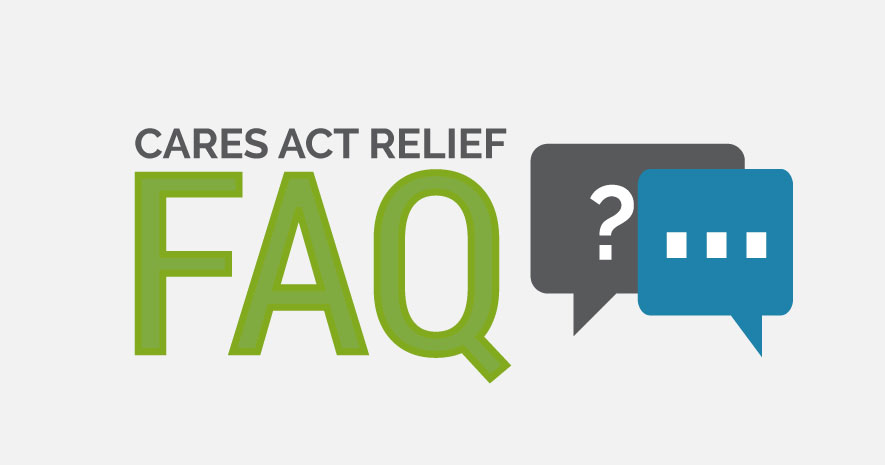The Coronavirus Aid, Relief and Economic Security (CARES) Act was a rapid response by the federal government to help businesses and employees cope with the economic issues caused by the pandemic. Many aspects of the wide-range law make significant changes affecting employer-sponsored retirement plans and their participants.
Since Congress passed the CARES Act in March 2020, we have received numerous questions from plan sponsors about the law’s impact on plans and participants. Below is a list of some of the most common questions plan sponsors face, along with our brief answers.
Are sick leave and family leave payments that are mandated by the Families First Coronavirus Response Act (FFCRA) treated as plan compensation?
Probably, yes, since FFCRA paid time off would be included in Box 1 of Form W-2 and many retirement plans define “compensation” as including Box 1, W-2 compensation. But plan sponsors will need to look at how their plan defines “compensation.” If paid time off is excluded, then FFCRA paid time off would likewise be excluded (but such exclusion seems to be rare).
What are the most commonly adopted provisions from the CARES Act?
According to research from Plan Sponsor Council of America, 46% of surveyed plans have elected to allow repayment of coronavirus-related distributions during the next three years, followed closely by 45% allowing some distributions until December 31, 2020. Only 9% of those surveyed adopted or plan to adopt no provisions.
What is the difference between “temporary impairment” and “other than temporary impairment”?
These are accounting principles used to describe the nature of the decrease in an asset’s value, which is a standard topic that needs explanation in the plan’s audit. “Temporary impairment” refers to normal market fluctuations in a specific investment; “other than temporary impairment” refers to a permanent decline in the investment with little to no chance of recovery. Given the extraordinary nature of the COVID-19 pandemic and its varying economic impact across industries and businesses, it is important to work with auditors to determine the correct classification of losses.
How can plan sponsors change the timing and frequency of the employer matching contribution from each pay cycle to a year-end contribution?
There are IRS and plan document limitations related to changes in certain types of Employer contributions, such as Safe Harbor contributions. However, generally, a sponsor can more easily change the timing of the deposit of those contributions into the plan, rather than change the formula and eligibility provisions of the Employer contribution. When cashflow is tight, consider funding the contribution on an annual, quarterly, monthly, or per payroll period basis to fit your needs. Employers generally have until the extended due date of their federal income tax return for that tax year to deposit Employer contributions into the retirement plan. Plan sponsors should check their plan documents (and summary plan description) to see if an amendment is needed to change the timing of when Employer contributions are made to the plan.
Do plan sponsors have to implement the CARES Act provisions for the new distribution and loan options?
The CARES Act expanded current rules on coronavirus-related distributions and loans, increasing the amount affected participants can pull from their accounts as well as the time they can take to repay the money, if applicable to the transaction. It’s important for plan sponsors to understand that the distribution and loan provisions are optional, as outlined in IRS Notice 2020-50. Plan sponsors should be aware that they may choose amongst the provisions and adopt the ones that they feel their participants would benefit from the most.
If plan sponsors implement a change to their plan allowed by the CARES Act, when should the plan document be amended to reflect the change?
Plan sponsors are permitted to make the CARES Act options available immediately even before a written amendment is made to the plan document. The deadline to formally adopt the amendments has been extended to December 31, 2022 (for calendar years) or the end of the plan year starting in 2022 (for non-calendar years).
Can plan sponsors stop making employer contributions?
In general, plans can reduce or eliminate discretionary non-elective and discretionary matching contributions without needing to amend plan documents, but plan sponsors need to examine plan documents to make this decision. Note that plans operating as Safe Harbor plans face a different set of requirements.
Can participants still take a Required Minimum Distribution (RMD) even though RMDs were waived for 2020?
Yes, but only if the plan allows withdrawals. The CARES Act allows participants to waive the RMD for 2020, but the law does not prohibit participants from taking a withdrawal. First, check the plan document to see whether withdrawals are allowed; then, see whether the plan has relaxed withdrawal rules as a result of the CARES Act to determine maximum amounts.




